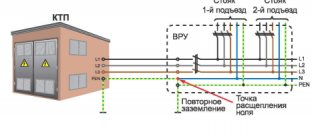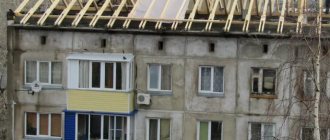Is the plasterboard partition that covers the riser considered a redevelopment?
So in Article 25 of the RF Housing Code, part 2 it is written:
Redevelopment of a residential premises is a change in its configuration, requiring changes to the technical passport of the residential premises.
Here the question arises whether a change in the form of a plasterboard wall is a change that must be made to the technical passport of the room. We look at the resolution of the State Construction Committee of the Russian Federation dated September 27, 2003 N 170 “On approval of rules and standards for the technical operation of the housing stock” (RG. 2003. October 23) provides approximate types of changes to the premises for these groups, in part 1.7.1.
Redevelopment of residential premises may include: moving and dismantling partitions, moving and installing doorways, disaggregating or enlarging multi-room apartments, installing additional kitchens and bathrooms, expanding living space through auxiliary premises, eliminating dark kitchens and entrances to kitchens through apartments or residential premises, installation or refurbishment of existing vestibules.
That is, our plasterboard wall is not subject to redevelopment. As a result, such a change will not require inclusion in the technical passport.
Arbitrage practice
Perhaps the main argument in favor of the importance of discussing in detail the boundaries of operational responsibility in a resource supply agreement will come from examples from judicial practice.
Managing organization
filed a lawsuit to declare the terms of energy supply contracts invalid and to order the obligation to transfer heating networks to the area of responsibility of the RSO. The court refused to satisfy the claims, since the Criminal Code agreed on the boundaries of the balance sheet, accepting the disputed section of the networks for its maintenance (Resolution of May 23, 2012 in case No. A63-9362/2011).
The court may make a different decision if the boundaries of the balance sheet in the act are indicated differently than along the external wall of the apartment building
or at the installation point of the metering device. In this case, the act of delimiting balance sheet ownership is invalid (Determination of the Supreme Arbitration Court of the Russian Federation dated June 26, 2012 N 6421/12 in case N A14-11374/2010).
When concluding the contract, disagreements arose between the parties regarding the limit of operational responsibility, since there was no act of delimitation of responsibility, the court decided to determine the limit of operational responsibility in accordance with the Rules for the maintenance of common property
(Resolution of the Arbitration Court of the Central District dated May 21, 2015 N F10-1143/2015 in case N A68-2267/2014).
And according to the FAS Decree UO dated February 28, 2011 No. Ф09-443/11-С5, in a similar situation, there is no demarcation of responsibility concluded
the court concluded that the line of operational responsibility should run along the line of balance sheet ownership, in other words, along the line of division of utility networks between the owners.
If you have any questions, you can always contact us for advice. We also help management companies comply with 731 Russian Federation Regulations on the Information Disclosure Standard
(filling out the
housing and communal services reform
, the management company website, information stands) and Federal Law No. 209 (). We are always happy to help you!
Overhaul: waiting list
Before talking about the order of major repairs of apartment buildings, it is advisable to touch on the basics of the Federal legislation (FL) regulating this issue.
| №/№ | The legislative framework | Decoding |
| 1. | Housing Code of the Russian Federation Art. No. 166 | Lists the repair work carried out as part of the overhaul |
| 2. | Housing Code of the Russian Federation Art. No. 154 | It is said that the financial costs of major repairs must be borne by apartment owners |
| 3. | Housing Code of the Russian Federation Art. No. 182 | It is said that the responsibility for major repairs lies with the regional operator |
The order of major repairs of apartment buildings should be established by a regional level program.
Subtleties of repair and replacement of utilities in an apartment
How to avoid problems? As a customer of repairs in your home, you need to determine the rules for the delivery and acceptance of work performed by the contractor. To this end, you will need to perform a number of actions.
1. It is necessary to draw up in writing a list of communications in the apartment that need to be disguised - hidden communications. You will spend no more than 15 minutes on this. To make your work easier, use the list of communications below, which are most often hidden under the floor, in the walls, under the ceiling:
- power and lighting wiring;
- potential equalization bus;
- coaxial television signal cables;
- telephone cables (wires);
- cables (wires) of a video intercom network, electric bells;
- data network cables (twisted unshielded pair);
- speaker cables;
- central heating pipes;
- water supply pipes;
- sewer pipes;
- channels and pipelines of ventilation systems;
- cable system for “warm floors”;
- pipelines, power and signal circuits of apartment ventilation systems.
2. Then, in the resulting list, indicate the engineering, access to which must be provided for the purpose of inspection and maintenance.
It is recommended to provide access to the following utilities in the apartment:
- technological passages for cleaning sewers;
- shut-off, filtration, distribution valves of the water supply network;
- potential equalization bus;
- lighting network transformers.
3. Remember that gas supply pipes and the gas shut-off valve must always be visible. Also think about this: hidden central water supply pipes are certainly beautiful, but is it worth it?
4. Of course, it is difficult at the very beginning of the renovation to fully imagine what your home will look like after it, but it is recommended to think in advance where the following will be located:
- built-in wardrobes;
- built-in, wall-mounted cabinet furniture;
- curtain rods;
- hanging mirrors, accessories, lighting;
- air conditioning systems.
The ideal option is when you have a project for the apartment's utilities before the start of work. Thanks to it, it will be possible to stick to the chosen direction, and risks and additional costs will be eliminated.
You should not lay engineering where the fastening elements will be located. Consult with the contractor: an alternative opinion will always help you make the right decision. It is best when hidden communications are separated from the places of subsequent arrangement of furnishings at a sufficient distance. It is critical if the distance between the installation point and the hidden communication is less than 15 cm.
5. Before the contractor begins renovating the home, he is required to hand over all communications to you before they are sealed. Here you will need constant monitoring. If the contractor begins to account for his every step, hidden communications will be carried out efficiently, and the sequence of work will be planned by him as rationally as possible.
6. Take a camera and photograph all the engineering as it is being handed over by the contractor.
By following the above action plan, you will protect yourself from unscrupulous work of the contractor, eliminating the possibility of costs for altering hidden communications in your home. In addition, you will have all the documents for the further use of utilities in the apartment.
What is included in the common property of an apartment building under the Housing Code of the Russian Federation
Have questions? Consult a lawyer (free of charge, 24 hours a day, seven days a week):
8 Moscow and Moscow region.
8 St. Petersburg and Len. region
Common property - this phrase is familiar to all homeowners who pay monthly housing and communal services bills. But few people really understand what it means and what money is paid for on payments. What property is included in the list of common property, whether it can be used, what part belongs to each tenant - all this can be understood by carefully studying the section of the Housing Code of the Russian Federation “Common Property of an Apartment Building”.
Air conditioning, climate systems
During the summer, residents of apartment buildings suffer from the heat. The most effective solution for optimizing climatic conditions in each individual apartment of a modern house is a central refrigeration supply system using fan coil units, the principle of operation of which is described above, or so-called individual comfort units. If such a system is not provided in the house, then at a minimum there should be special places for air conditioners and a drainage system should be implemented.
Threaded connection
This type of connection is used for pipelines with the largest diameter - up to DN-50 and for pressures up to 1.6 MPa. In this case, the thread is present on both the pipe and the fittings. Even if there is no thread on the pipeline, it can always be cut. At one end of this type of fitting there is a hexagon for the possibility of using an adjustable wrench for screwing.
Fittings with threaded connection.
Threaded connections come in two versions - with internal thread and external thread. There may be different threads on both sides of the product - internal on one and external on the other, or identical on both sides. Thread standards are also different.
The threaded connection is strengthened by using sealants - flax thread, FUM tape, thick lubricants. This connection is used for installation of a wide variety of shut-off valves - valves, gate valves, flow separators.
The advantages of threaded connections include the absence of additional elements for installation, low price, ease of installation and replacement. The downside is that it is unsuitable for high-pressure lines.
Union connection
This type is used to connect fittings of very small diameters - up to DU-5. In this case, the connecting end has an external thread and is pressed against the pipe with a union nut. By means of a fitting connection, various measuring instruments are introduced into the main line.
Fittings with union connection.
It is used for a small list of specific pipes such as laboratory ones.
Welded joint
A welded connection is necessary on those highways that pass through media hazardous to health. Perfect tightness is needed here, since even the slightest leaks are unacceptable. The main condition is that the weld seam should not be weaker than the pipe wall.
Welding fittings.
Connections are made in two ways:
- Butt joint, when the clutch is supplemented with a washer ring to prevent misalignment of parts.
- In the bell. In this case, the welding seam is located on the outside of the pipe.
A proper welding connection is the most reliable and 100% sealed. Welding is preceded by preparation of the pipe ends. The advantages of a welded connection include low cost, low weight, and small dimensions.
The disadvantages are that using this connection method is impossible without the involvement of qualified personnel. Dismantling the fittings is very labor-intensive.
Shut-off valves for toilet flush barrel
Toilet fittings.
In everyday life, you often have to deal with fittings for the toilet flush barrel. More details about it, its types, correct installation and adjustment can be found in a separate article: drain fittings for a toilet barrel.
Classification of shut-off valves according to the method of flow regulation
Depending on how the flow of the working medium is controlled, shut-off valves are divided into the following types:
- Cranes.
- Shut-off valves.
- Dampers.
- Valves.
Crane characteristics
They come in ball and cork types. The former are used mainly in household pipelines. The second are in highways transporting oil fractions, gas, and water. In the first case, the element that cuts off the flow is a ball, in the second, it is a cone in the shape of a plug.
The design of the shut-off valve is extremely simple. The main parts are the body and the locking element. Depending on the performance, the fittings are divided into full bore (90 - 100%), partial bore (40 - 50%), standard (70 - 80%). Adjustment is carried out using a flywheel or electric drive. There are taps with remote control.
Tap.
The main element of a ball valve is a lock, which looks like a chrome-plated ball; there is a hole along one of its axis. It is located between two o-rings (seats) in the center of the body. The locking parameters depend on the pipe cross-section.
Ball gran device.
Opening/closing occurs when the steel ball moves while the lever is turned. When the hole is oriented along the longitudinal line of the pipe, the working medium is supplied. When the hole is perpendicular, the flow is blocked. There are no rubbing elements in the design of this fittings, which is why water losses are insignificant.
The most popular ball valves are brass and steel, made of carbon, stainless steel and molybdenum-containing steel. There are plastic ball valves that are resistant to aggressive chemicals. The tightness of such products is low; they are highly sensitive to solid inclusions in the flow and at high temperatures.
They are introduced into both cold and hot water supply systems, but with a temperature not exceeding 65⁰. Stainless steel taps are built into pipelines with a diameter above 50 mm. The products are designed to operate under conditions of high temperatures and pressure. These taps are too expensive for household use.
Shut-off valves
These are fittings designed to both shut off and regulate flow. They are manipulated using a flywheel or electric drive. Different specimens are designed for specific temperature conditions. Large models are most often flanged, while small ones are connected with couplings.
Shut-off valve device.
Valves maintain the required pressure in the line, and also mix liquids in a given ratio. The shut-off assembly regulates the flow as follows:
- The flywheel transmits its rotational movements to the spindle.
- It begins to move, making reciprocating movements.
The spindle is started manually or via a servo drive. The most popular type of valve is a straight-through valve. They cut it into flat sections of the highway. The main disadvantage of this type of fittings is the considerable hydraulic resistance.
Diagram of a direct-flow valve.
Direct-flow valves do not have this drawback. They are installed in areas where the flow of the liquid medium at its outlet cannot be reduced. Valve bodies are made of cast iron, steel, bronze, and brass. The first ones belong to general technical shut-off valves and are connected using flanges and couplings.
In high-tech processes, where the requirements for the working environment are particularly stringent, steel valves are used. They have a flange connection.
The following video shows the appearance of various valves, as well as their structural design.
Valves made of bronze and brass are used in water supply and heating systems of buildings. They are connected using flanges, by welding or coupling. The direction of fluid movement is indicated on the body. The flow is regulated by means of a spool located on the rod.
Features of dampers
Shut-off elements of this type are installed in low-pressure systems, since they do not provide greater tightness. These are sewer lines and those with chemical liquids. The dampers are connected using flanges or welding. The locking part is a disk that rotates around an axis. Most often, the body is cast iron and the disk is steel.
Damper device.
Valves
These locking units are an extremely simple design that blocks the free movement of the medium. They can withstand high temperatures and pressure. They are used in highways that carry non-aggressive compounds. Their locking element is a wedge, disk or sheet. It carries out reciprocating movements, vertical with respect to the axis of the moving avalanche.
Gate valve device.
Valves are divided into full bore and truncated. For the former, the seat diameter and the corresponding pipeline parameter are the same. Secondly, the cross-section of the saddle is smaller than the cross-section of the pipe. These shut-off valves are installed on lines with a connecting diameter exceeding 50 mm. The flow in them must be shut off smoothly so as not to provoke a water hammer.
The advantages of gate valves over other types of similar products are their simplicity of design and maintenance. They have small dimensions and low resistance. They are made from cast iron, steel, and non-ferrous metals. They are controlled manually, using a hydraulic or electric drive.
Marking of shut-off valves
The key dimensions of shut-off valves of all types comply with GOST, so manufacturers must leave the appropriate markings on the product bodies. It contains information about the manufacturer, material, remote control, working dimensions. Standardization of parameters simplifies the installation of fittings, and marking makes selection easier.
Construction fittings.
In addition to shut-off and pipeline valves, in construction we often have to deal with fittings in the form of steel or plastic rods.
Very often, such reinforcement is used to create a load-bearing frame inside concrete structures.
More information about this type of reinforcement can be found in a separate article: construction reinforcement, types of characteristics.
Arrangement of intra-house sewerage
Taking into account the purpose of the building, it is necessary to provide it with high-quality internal sewerage:
- sanitary - for draining domestic wastewater from plumbing fixtures (sinks, urinals, toilets, etc.);
- industrial – for drainage of industrial wastewater from work areas.
Intra-house domestic sewerage involves the installation of a gravity pipeline (mostly a closed type).
Industrial wastewater may be disposed of using open chute structures if it does not emit substances, gases and vapors hazardous to health and the environment.
All types of sewerage must be laid with the required slope so that the wastewater flows independently through the system.
Standards for laying lines
The drainage pipes are connected to the risers using oblique crosses and tees. It is necessary to connect several plumbing elements (placed on the same level) to the central sewer pipe using oblique crosses.
Intra-house sewerage must be done using plastic (cast iron) pipes and high-quality fittings, the service life of which is at least 25 years. Moreover, the fittings must be resistant to hydraulic pressure during the service life of the system.
Experts advise using polymer pipes and connecting devices.
In this case, installation provides the following:
- hidden installation of risers (in shafts and special protective decorative boxes);
- use of non-flammable materials for the manufacture of shafts and boxes;
- use of facing materials for finishing shafts and ducts with flammability class “G2”;
- open laying of polymer pipes in basements;
- thermal insulation and cementation (20-30 mm thick) of the riser section, rising 8-10 cm above the ceiling.
It is prohibited to use a hidden method of laying sewerage in the walls, ceilings and floors of living rooms.
It is possible to simultaneously use several sewer systems in large industrial buildings to discharge wastewater with various aggressive environments into treatment systems.
It is necessary to separate domestic and industrial sewage systems taking into account the wastewater emanating from them, because they are cleaned and processed differently.
Ventilated risers: calculation and installation
It is necessary to use vertical ventilated risers in any home, which will allow wastewater to flow naturally through the pipes. They must be brought to the roof of the building through the roof.
On buildings with a flat and pitched roof structure (not in use), the drain pipe must be installed above the roof level by at least 20 cm. Moreover, the end of the riser pipe must be located at a distance of at least 4 m from the windows.
On exploited roofs, the end of the pipe should be located 3 m or more above the roof, and it can combine 4 or more separate risers of the building. It is allowed to place the riser below the roof being used, only in this case it is necessary to install a check valve that allows air only into the pipe.
The valve must be installed at the level of the plumbing fixtures located at the highest point of the sewer system.
The required number of risers is calculated using the following formula:
N=kW/Q,
Where:
- N – number of risers;
- k – air exchange rate per riser, l/day (norm 80-100);
- W – volume of the system in m3;
- Q – daily volume of dirty air at the outlet of the riser, m3 (calculated norm 320).
The depth of the sewer pipeline must be selected taking into account the possible loads on it during operation. If there is a risk of damage, the pipeline must be reliably protected.
Areas where the air temperature can drop to negative values must be properly insulated. Otherwise, the internal sewage system will freeze and a blockage will form, as a result of which wastewater will begin to flow into the house.
The slope for sewerage is calculated using the following formula:
1/D,
where D is the diameter of the installed pipe.
Intra-house networks of residential and domestic premises must be laid at a level of 10 cm from the floor. Deviation of the slope on horizontal sections of the drainage pipeline is not allowed.
In buildings and extensions it is necessary to install plumbing fixtures to receive the required volume of wastewater. The number of these devices is determined by the developed and approved building design. Each element of plumbing must be equipped with siphons (hydraulic seals), which will block the release of unpleasant odors from the sewer into the building.
What's on the list?
According to the Housing Code, its list includes:
- Premises extending beyond the boundaries of the apartment: flights of stairs, landings, corridors, basements, technical floors, attics, elevator equipment. Quite often, technical floors and basements are sold as office non-residential premises. However, paragraph 1.1 of Article 36 states that the list includes basements and technical floors that have common engineering communications, as a result of which some of such premises in any case belong to common property.
- Other premises not owned by the owner. In particular, if you and your neighbors have set up a gym in your basement, then it belongs to all owners by right of common property.
- Roofing, load-bearing elements of the building, chimneys, other equipment located in the building or outside its boundaries, used to serve 2 or more apartments or premises.
- A plot of land on which an apartment building is located, together with landscaping elements: parking, landscaping, playgrounds for children and other things related to this building within the limits established by the relevant codes.
Accordingly, government decree No. 491 classifies the same property as common property. So, let's look at the official terms in more detail.
Balcony
But with the roof of the balcony on the top floor, everything is more complicated. If it was included in the house design, then it is common property. If the owner made the roof of the balcony himself, then this is private property.
Heating riser
In accordance with Government Decree No. 491, paragraph 6, it turns out that the heating system riser is also common property.
Heated towel rail
A heated towel rail is an integral part of the home's hot water supply system. In accordance with Government Decree No. 491, paragraph 5, paragraph 1:
Sewer riser
The second paragraph of the same paragraph 5 of the resolution states that private property ends where the first joint branching from the sewer riser is located.
Metering systems and low-current networks
The trend that has emerged in recent years to monitor the consumption of heat, water and energy resources has now spread to the residents of Vladivostok. That is why rational and well-thought-out accounting systems are increasingly of interest to people choosing their ideal housing. The best option in this case is apartment-by-apartment remote metering of all energy resources with output to a single control center.
In conclusion, I would like to say that in the age of high technology, an important role in the engineering systems of apartment buildings is played by the presence of low-current networks, which make it possible to use such benefits of civilization as satellite, cable and HD television, the Internet, etc. The presence of an installation box in the apartment will also be an undeniable advantage.
Large-scale amendments have been made to the Rules for the Provision of Utility Services regarding “direct contracts” with RSO
| pakphoto/depositphotos.com |
The Government of the Russian Federation has made changes to the text of three important “municipal” documents (Resolution of the Government of the Russian Federation of July 13, 2021 N 897):
- Rules for the provision of utility services to owners and users of premises in apartment buildings and residential buildings, approved. Decree of the Government of the Russian Federation dated May 6, 2011 No. 354,
- Rules for concluding resource supply agreements between RSO and the management company, approved. Decree of the Government of the Russian Federation dated February 14, 2012 No. 124,
- Requirements for organizing payments for utility resources, approved. Decree of the Government of the Russian Federation dated March 28, 2012 No. 253.
Almost all of these changes are dictated by the need to detail the rules related to the provision of utility services to residents of apartment buildings directly by resource supply organizations (RSOs) - under the so-called “direct contracts”. Another part of the amendments is related to strengthening the legal status of the register of licenses for managing apartment buildings, and most of the rest are of a technical and legal nature.
- a standard “direct agreement” was approved - an agreement between the owner of a residential premises in an apartment building and the RSO on the provision of utility services, including those consumed during the maintenance and use of common property in an apartment building. The conclusion of just such standard agreements between apartment owners and RSO is expressly provided for in Part 6 of Art. 157.2 Housing Code of the Russian Federation. Let us recall that owners of non-residential premises (except for parking spaces) have long been required to conclude individual written resource supply agreements with the RSO, and separate agreements with the MSW management operator for the provision of services for the management of solid municipal waste. By the way, a standard “direct agreement” for the management of MSW is also mentioned in the amendments under consideration - it will be part of Regulation No. 1156 of November 12, 2016;
- if the transition to “direct contracts” in a particular apartment building has taken place - at the will of residents or RSO, it doesn’t matter - the management company is obliged to transfer to RSO a large amount of data about the owners of the premises no later than 5 working days before the day from which RSO will begin providing utility services (if the transition to “direct contracts” occurred due to the debts of the management company; it is also obliged to transfer this data within 5 working days from the date of termination of its contract with RSO). This data is needed to calculate utility bills; among them - full name, passport details, telephone number, E-mail of each owner and user of residential premises, addresses of residential premises indicating the total area and number of residents, details or a copy of the document on ownership, all information about the private ownership and other information, including about "debtors".
A similar rule is being introduced for data transferred to the regional operator for the management of MSW.
It is not necessary to obtain the consent of the subject of personal data to transfer this information.
- If the management company does not transmit this information or does not transmit it on time, and because of this, payments will be erroneously charged to the consumer, and RSO pays a fine for this error, then the management company will reimburse the RSO for the amount of this fine. By the way, in their applications for payment of a fine, consumers must now indicate their Taxpayer Identification Number;
- The management company is obliged to provide the RSO and the registrar for the management of solid waste not only with the above information, but also information from the register of owners (full name indicating the size of shares in the common property of the apartment building), and also constantly update this information in the future;
- and information from the register of owners, and all other information necessary for the calculation of fees by the RSO, the management company must transmit simultaneously on paper and in electronic form;
- The deadline for verifying the consumer’s request for the correctness of the payment amounts accrued to him can be considered within a month. This applies equally to the management company, the RSO, and the registrar;
- the procedure for switching to “direct contracts” is being clarified (in full compliance with the Housing Code of the Russian Federation), with particular emphasis on the obligation of RSO to disseminate to its “direct” consumers the information that the provider of public services must provide (recently, cases of punishment of RSO have become more frequent for failure to comply with this obligation);
- stipulates the obligation of the initiator of the general meeting of owners of premises in an apartment building, which decided to switch to “direct contracts”, also to inform his housemates of the information received from the RSO (dates of conclusion and start of execution of “direct contracts”, terms and methods of transmitting IPU testimony, etc.). P.). This information must be conveyed by posting on notice boards at all entrances of the apartment building or adjacent land plot, within 5 calendar days from the date of its receipt from the RSO;
- management companies are responsible for the maintenance of in-house engineering systems, even if residents are under “direct contracts” with the RSO/reg operator - this is expressly provided for by the new edition of Rules No. 354. RSO is always responsible only for the supply of resources to the border with in-house engineering systems;
- The management company must accept consumer reports of poor-quality utility services - even in the case of “direct contracts”. You need to check this message and draw up a report together with the RSO/regional operator. The emergency dispatch service is also the “patrimony” of the Management Company;
- the obligation of the management company to install ODPU even in a house under “direct contracts” is directly stated, but only if the owners of the premises in the apartment building have decided to include the costs of acquiring and installing ODPU in the fee for the maintenance of the residential premises;
- It is no longer necessary to warn debtors about the limitation/suspension of utility services in writing - it can also be done orally. And the amount of expenses for restricting/suspension of utility services that can be recovered from a consumer-debtor is limited to 3,000 rubles;
- if the management company cannot confirm that the apartment building it manages is included in the regional register of licenses for managing apartment buildings, then the RSO has the right to refuse to enter into a resource supply agreement with the management company in terms of providing resources for this controversial apartment building.
We also note that Rules No. 354 now include a ban on placing advertising in a payment document, with the exception of social advertising. Let us remind you that advertising on payment cards was banned last year - see part 10.2. Art. 5 of the Law on Advertising. Now this prohibition is directly provided for by Rules No. 354.
Internal operational boundaries
The boundary of operational responsibility between the management company and the owners when it comes to the internal boundary of utility networks that are part of the common property
MKD are:
- for heating - valves on the heating pipeline connections to the apartment radiator. If there are none, then the boundary passes along the threaded connection in the radiator plug.
- for cold and hot water supply - a valve at the pipeline outlet from the riser. If it is not available, the boundary is the weld seam at the pipeline outlet from the riser.
- for drainage - a socket of a shaped product (tee, cross, bend) on the riser of the drainage pipeline.
- for power supply - the place where the outgoing wire of the apartment electrical wiring is connected to the plug of an individual electricity meter, circuit breaker, RCD.
The boundary of operational responsibility between management companies
and the owners (we are talking about the internal border of building structures that are part of the common property of an apartment building) are the inner surface of the walls of the apartment, window fillings and the entrance door to the apartment.
The enclosing load-bearing structures, the land plot (including children's and playgrounds, collective parking lots) on which the house is located, landings, corridors, roofs and attics, as well as elevators are in the area of operational responsibility
UK.
Causes of odors from ventilation
The main reason for the appearance of foreign odors from the ventilation system is the effect of draft overturning. The physics of the process is as follows: the higher the temperature of the atmospheric air and the lower the temperature in the room, the worse the natural draft. Under certain conditions, instead of removing air masses, through a vent. air begins to flow into the grate. In other words, if there is insufficient draft in the exhaust shaft and poorly organized air flow in the apartments, the air flow created by your neighbors’ kitchen umbrella can enter the rooms higher up the riser.
It’s easy to check for “reverse draft”: you need to hold a strip of paper to the ventilation grille.
The appearance of odors from your neighbors' exhaust ventilation may be due to the lack of plugs. For example, consider the ventilation system of one riser of a typical multi-storey building (series II-18, I 209A, etc.). It consists of a common shaft and two acceleration channels. The system works like this: the polluted air from the apartment must rise through the acceleration channel to a height of 2.5 - 2.7 m (depending on the project), “rest” against the plug (on the floor above) and exit through a special “window” into the common shaft. The problem is that in 90% of cases there are no such plugs! Without plugs, such a system, consisting of a common shaft with two channels (divided by plugs into booster sections), turns into three transit shafts.
Sources
- Legal regulation of the activities of organizations providing services in the field of healthcare, education and culture; Jurisprudence - M., 2013. - 633 p.
- Tati Ioanna Agni Job Balance. Capitalism. Socialism. Balance of Light; Publishing solutions - M., 2021. - 362 p.
- Anatoly Nikolaevich Kuznetsov Criminal procedural acts 2nd ed. Textbook for open source software; Yurayt - M., 2021. - 539 p.
- Kishenkova O. V. Social science. Preparation for the Unified State Exam in 2014. Diagnostic work; St. Petersburg [and others]: St. Petersburg - Moscow, 2014. - 203 p.
- Andreevsky Sergey Case of Naumov; Mechanical engineering - Moscow, 1986. - 150 p.
Electrical devices
The specifics of the power supply of elite residential buildings are determined by increased requirements, firstly, to the calculated (installed) power consumption, which in some cases reaches 30 kilowatts or more, and, secondly, to the system of safe operation of the electrical installation. Therefore, it is preferable to use power distribution of the TN-S network type, and equip the outgoing feeders of the apartment distribution boards with RCDs (residual current devices).
The distribution network and power equipment system for general building systems, including connections to apartments, are carried out at the first stage of construction and are presented to the customer - the developer of the house for delivery to the acceptance committee. The distribution network of the apartment, as well as the calculation and selection of circuit breakers for electrical consumers, are determined at the second stage in agreement with the buyer of the apartment.
There are several options for designing an intra-apartment distribution network:
- in a false ceiling;
- in electric baseboards;
- in grooves;
- with partial laying of the proposed highways in special mortgages at the first stage of construction (when performing work on a monolithic floor) with further electrical wiring to specific equipment in agreement with the customer - the buyer of the apartment.








